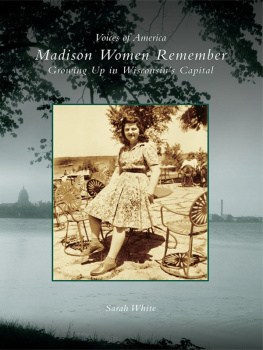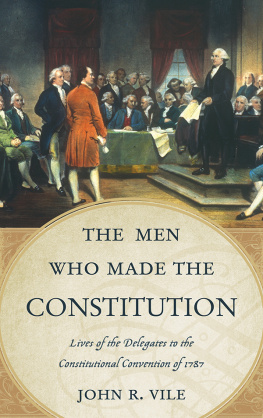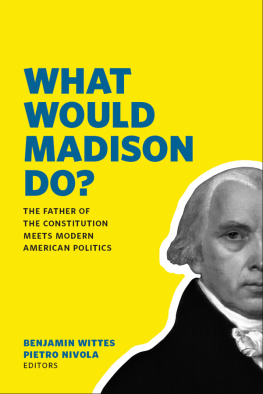MADISONS
HAND
Revising the Constitutional Convention
Mary Sarah Bilder
Cambridge, Massachusetts
London, England
2015
Copyright 2015 by Mary Sarah Bilder
All rights reserved
Cover art: Bridgeman Images
Cover design: Graciela Galup
978-0-674-05527-8 (hardcover : alkaline paper)
978-0-674-49550-0 (EPUB)
978-0-674-49549-4 (MOBI)
The Library of Congress has cataloged the printed edition as follows:
Bilder, Mary Sarah, author.
Madisons hand : revising the Constitutional Convention / Mary Sarah Bilder.
pages cm
Includes bibliographical references and index.
1. United States. Constitutional Convention (1787) Journal of the Federal Convention. 2. Constitutional historyUnited StatesSources. 3. Madison, James, 17511836. I. Title.
KF4510.B55 2015
342.7302'92dc23
2015009815
CONTENTS
- I
- NOTES BEFORE THE CONSTITUTIONAL CONVENTION
- The Genre of Legislative Diaries
- The Practice of Working Notes
- II
- LEARNING TO KEEP A CONVENTIONAL DIARY
- The Success of the Opening Days
- Struggling with Speeches
- III
- RECORDING THE CONSTITUTIONAL CONVENTION
- An Account of Failed Strategies
- Acquiring a New Role
- IV
- ABANDONING THE NOTES
- The Complexity of Drafting
- The Conventions Changing Relevance
- V
- COMPLETING THE NOTES
- Correcting and Revising the Notes
- The Influence of Mr. Jefferson
This book uses simple numerical references for Madisons Notes. The absence of page numbers in the manuscript long has caused difficulties. In the 1790s, when John Wayles Eppes was copying the manuscript for Thomas Jefferson, a sheet containing part of the September proceedings appeared to be missing. Eppes wrote there appears to be wanting in this place part of a days debate. But the absence of page numbers left Eppes uncertain.
I refer to the manuscript as if Madison numbered every folded sheet of paper. Madison later referred to his pages as sheets. He folded a large sheet (a paper size called post, approximately 9 inches high and 15 inches wide). The fold created four writable pages. After using a sharp point to rule margin lines, Madison placed the fold on the left. He began writing on that first page. He then opened the sheet, wrote down the left and then right side. He closed the sheet and finished writing on the back. While many sheets remain intact, a number have been torn at the center margin and are in two pieces. On others, the inside margin is adhered together at the foldlikely the result of hinges used by earlier archivists.
Although specialists refer to sheets as bifolia, for greater accessibility to a general reader, sheet is employed in the text. The manuscript references, however, have been numbered as bifolia. The manuscript consists of 136 bifolia. The first sheet of the manuscript is b.1. The last bifolium of the Convention proper is b.132. Each page of the sheet is referred to in the order in which it was written. The first sheet has four pages: b.1-1, 1-2, 1-3, 1-4. As an example, the first May 14 entry appears on b.1-1; the last sentence of the September 17 entry appears on b.132-4. A slip of paper added by Madison to the manuscript is referred to by the page on which it was attached. Slips are numbered in order of their sequence on the page. For example, Madison inserted the list of delegates on slip 1, b.1-1. As part of the manuscript, the sheets containing Madisons copies of Hamiltons plan and Randolphs July plan are included. The catalogue in the Evidence section lists the bifolia and slips. Adding 10 to these numbers will produce the current Library of Congress numbering system with two exceptions: the first two sheets and two sheets currently out of order.
Most specific references are to the manuscript or the transcript in The Documentary History of the Constitution. I have provided citations for specific information; general facts evident from any edition of the Notes are not cited. Sentence-terminating ellipses have been omitted. Letters have been silently capitalized or de-capitalized to read in accord with the surrounding sentences.
when men put a machine into motion it is impossible for them to stop it exactly where they would choose
George Washington as recorded by Thomas Jefferson (1793)
James Madisons record of the Constitutional Convention in Philadelphia in the summer of 1787 is the single most important source for the Convention. Politicians, judges, and scholars rely on the record, which was printed posthumously in 1840. The Library of Congress classifies the manuscript as a Top Treasure among the written documents it holds in trust for the American people. This recordMadisons Noteshas acquired iconic status. But, in the process, the Notes have become misunderstood. This book is the story of the making of the Notes. It is a biography of the Notes. It is inevitably also a history of James Madisons mind, of the politics of the Constitutional Convention, and of the gradual emergence of the Constitution.
Madisons Notes are the most complete and detailed description of the Constitutional Convention. An official record of the Convention was compiled by its secretary, William Jackson. In addition, notes survive from over ten other delegates. Madisons Notes, however, are the only ones that cover every day of the Convention, beginning on May 14 and ending on September 17, 1787. No other notes are as long. The manuscript is comprised of 136 sheets of paper, folded in half with four pages of writingover five hundred pages. In one modern printed edition, the Notes cover over 550 pages. Even a recent, significantly abridged version comes close to 150 pages. And no other notes depict the Convention as Madisons Notes do: as a political drama, with compelling characters, lengthy discourses on political theories, crushing disappointments, and seemingly miraculous successes.
To a remarkable degree, Madisons Notes created the narrative we inherit of the Convention. Over a century ago, Gaillard Hunt, the editor of the first modern scholarly edition of Madisons writings, proclaimed
As a reliable source, however, Madisons Notes are a problem. They were revised; indeed, this book will suggest, revised to an even greater extent than has been recognized. Yet revision has long been intertwined with the Notes. The first printed edition described the Notes as having been revised. In the initial edition in 1840, the editor included a letter from Dolley Madison explaining that Madison had them transcribed and revised by himself. A doctored reproduction of a partial page with revisions was reprinted in that edition. In the 1890s, the government published a lengthy transcript showing the visible revisions. In 1911, the influential publication, The Records of the Federal Convention of 1787, included selected revisions. In the 1930s, after discovering Madisons copy of the official journal of the Convention, Yale professors Roy Keller and George Pierson declared, the Debates were pretty extensively revised within a few years after the Convention closed.
Scholars have shied away from exploring the significance of the revisions. Their reluctance may arise from an anxiety about being perceived to accuse James Madison of manipulating the Notes. As James Hutson explained, there has been an undercurrent of skepticism about their accuracy ever since the 1840s, when Alexander Hamiltons son, John C. Hamilton, alleged that Madison inaccurately portrayed his fathers positions. More provocatively, in the mid-1950s, William Crosskey, a law professor at the University of Chicago, argued that Madison had forged pages in the 1820s. Madison biographer Irving Brant and James Hutson, chief of the Library of Congresss Manuscript Division, rejected the forgery claim based on watermark and paper evidence. The existence of revisions has been known but nonetheless largely unexamined.









